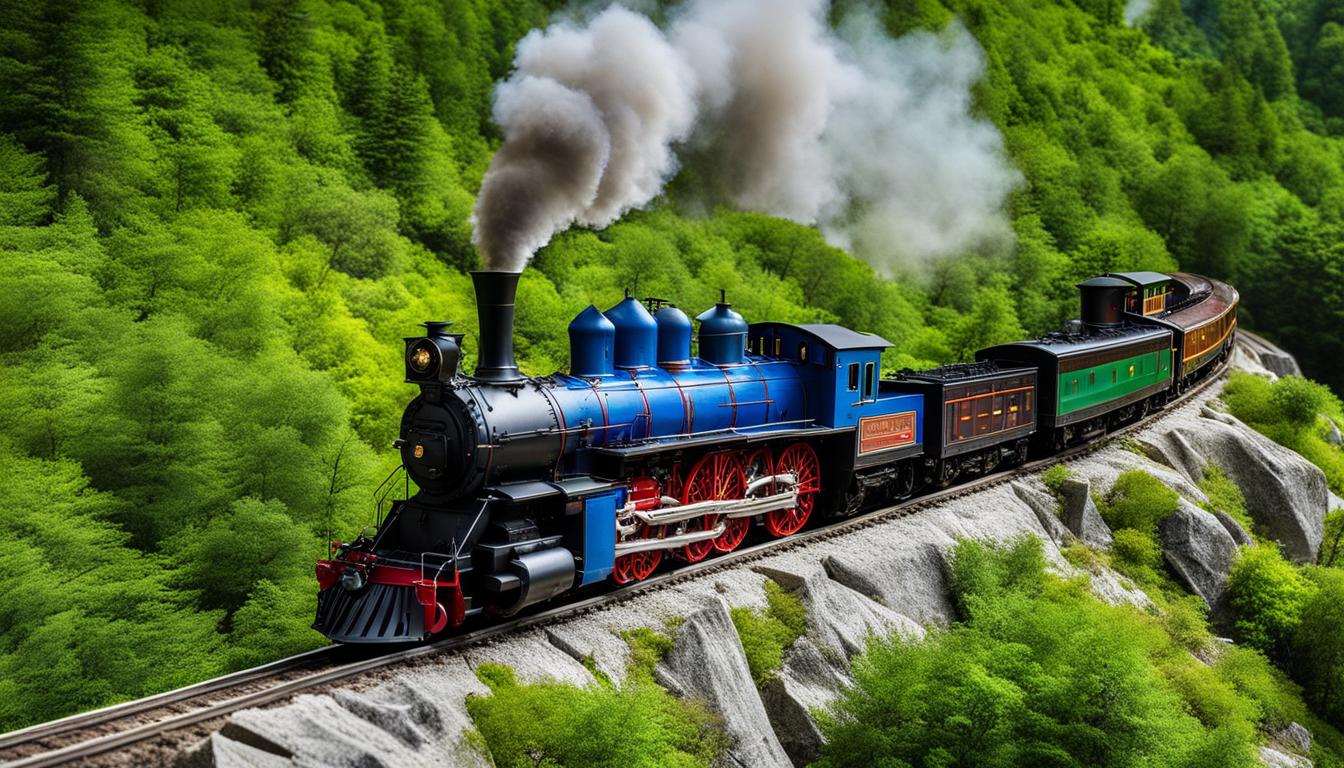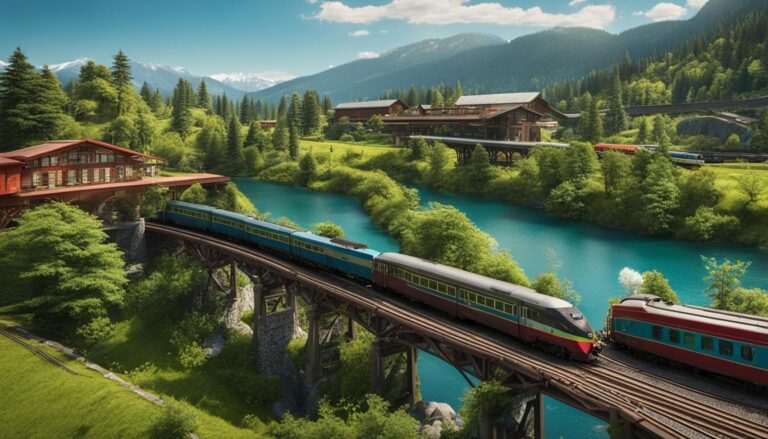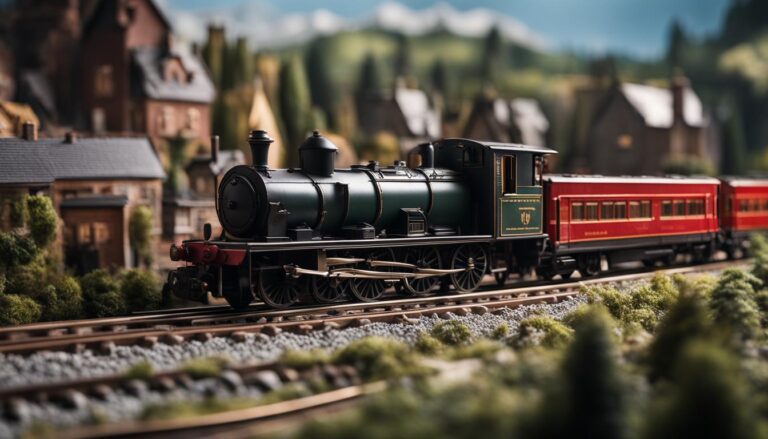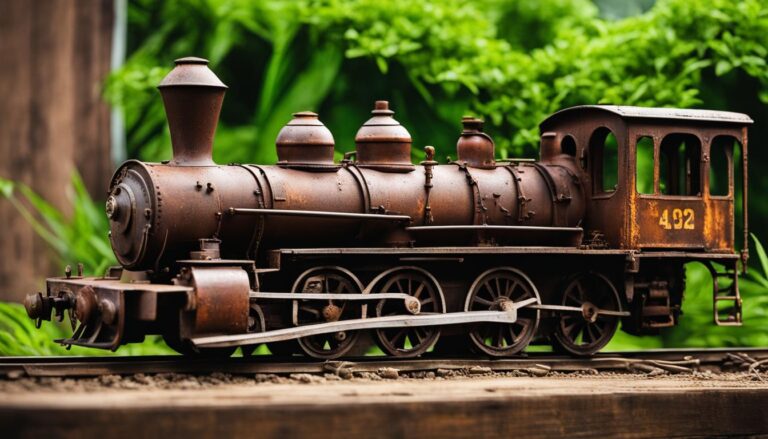Can Model Trains Go Uphill? Exploring Miniature Railways!
Can model trains go uphill and downhill? As a fan of model trains, I often find myself thinking about what these tiny machines can do. Secondly, let’s look into the mechanics and details of model trains to find the truth.
It is very important to know what makes a model train able to handle inclines. Everything about uphill operations is very important, from the design of the tracks to the specs of the trains. Let’s dive in and learn more about the world of model trains that can climb!
Key Takeaways:
- With the right design, track support, and train specs, model trains can go uphill.
- The grade, slope, and speed of the train are all important factors that affect how well it can go uphill.
- It is important for uphill tracks, including curves, to have the right shape and support for the tracks.
- Setting up guidelines for how to run on grades can make running model trains on uphill tracks more fun overall.
- People can get up steep hills in a very clever way with funicular railroads.
Factors Affecting Model Trains’ Uphill Capabilities
Starting with model trains is like arranging an intricate dance depending on how objects interact. The stage includes the track form, land slope, train uphill speed, and train’s innate capacity to manage hills. Like a symphony, the climb adds harmony or discord with each note. The next few pages will explain each component and show you how to make model trains rise smoothly over small landscapes.
Model Trains Track Design for Uphill Climbing
The shape of the track is very important for how quickly the model trains go uphill. The story goes forward with the help of the incline, which is a key character who sets the level of drama. This rise angle, shown as a percentage, is part of the whole climb and changes how smooth the train moves. But don’t forget about the other people on the track. They keep things stable and make sure nothing goes wrong. These are very important roles that were played correctly on this small stage. Fans of model trains think of the way the tracks are laid out as the person who builds uphill dreams by deciding what views will appear on each climb.
Evaluating the Model Train’s Uphill Speed
A model train’s trip uphill sounds like a sensitive ballet because of many things that work together. Because the hill changes the weight of the train, which is an important dancer in this show, it changes how easy or hard it is to keep going. The engine, which is the main character and really what makes the train work, and the way it’s built all work together to change the speed going uphill. A locomotive’s strength is like a maestro’s: it gives you the push you need to get up a tough hill and win. Everything works together to make the uphill sonnet of tiny movement as the wheels move up the hill.
| Factor | Impact on Uphill Climbing |
|---|---|
| Track Design | Determines the steepness of the grade and ensures stability |
| Train Weight | Affects the train’s ability to maintain speed on inclines |
| Locomotive Power | Provides propulsion to overcome uphill grades |
| Uphill Grade | Varies in steepness and must be compatible with train capabilities |
| Uphill Curves | Pose additional challenges and require proper track design |
Understanding Uphill Grades in Model Railways
For model trains, the climb is shown in poetic percentages, which are like lines in a well-written poem. They show how much height is gained per unit of distance. But each model train is different and has its own way of getting around rough ground. To do well in this show, you need to know how the train works, so choose a dance partner who does too. It’s important to pick a grade that fits the train’s skills so that the symphony runs smoothly. This will make the ride through the tiny world’s rising scenery smooth and beautiful.
Overcoming Challenges of Uphill Curves for Model Trains
The bends make a tricky dance for model trains as you go uphill. They decide how to trip by how the grade and turns work together. The hard part is keeping up the smooth beat and not making any mistakes that could mess up the small dance’s delicate rhythm. Well-designed tracks and steady support work together like a hidden conductor to make sure the climb goes smoothly through the cute turns and twists of the small landscape.
Understanding Model Trains Track Design for Uphill Climbing
The most important part of the complicated dance of model trains is how the tracks are laid out. It decides how high and low the little trains go over the rolling countryside. The train’s skills and the slope, which is shown as a number, work together in a way that is good for both. What makes the show possible are the angle of rise, which are like dance steps.
It is very important to match the grade with the locomotive’s skills and think about what the train needs. The track needs the right support to stay stable and not fall off. Think of it as the stable base that dancers stand on. Metal or wood are used to make the backbone, and the way the cross-bracing and support poles work together like dancers makes it even stronger.
As the train goes up, being smooth is a good thing, and the track is where this careful dance takes place. It’s not enough to just go uphill; the train has to make a lot of complicated moves that all have to work well with each other. There are turns, switch tracks, and changes in height in the routine. These stop the slopes from getting too steep and make sure the changes are smooth. The layout of the tracks in model railroading games tells a story. A lot of thought went into every part of the story of the great climbs.
| Track Design Considerations for Uphill Climbing | Key Points |
|---|---|
| Incline or Gradient | Choose a grade suitable for the train’s capabilities |
| Support and Stability | Ensure proper track support to prevent derailments |
| Smooth Surface | Create a level surface for optimal performance |
| Layout and Transitions | Strategically position the track for smooth transitions between sections |
Evaluating the Model Train’s Uphill Speed
The most important thing for model trains going uphill is how fast they climb. For this reason, it’s a careful mix of physics and design. At the beginning of the dance, the weight of the train changes the speed of the climb like a quiet partner. When a heavier train has to walk uphill, it can be hard, just like when a soloist has to take extra weight. What’s stopping it will make it move more slowly.
Its power, on the other hand, acts as a lead in this dance of tiny locomotives, pushing the train up against the resistance to make sure it goes with ease. The music is also helped by the way the train is built. Shaped bodies that are beautiful from an aerodynamic point of view are like agile dancers; they move through the air with ease, reducing wind resistance and making the climb smoother.
Better Grip
Some people find it even more interesting when spiked tires or other things that make it easier to grip are used. After being made, these shoes help the train grip the track better and move faster going higher.
A lot of work goes into making sure that the weight, power, and shape of model trains are balanced when they are going up hills. If you match the right partner to the slope, you’ll have both a useful climb and a beautiful dance, where each part works with the others to make a show that takes model train fans to a place where art and science meet.
| Factors Affecting Uphill Speed | Impact |
|---|---|
| Weight of the train | Heavier trains may struggle to maintain speed uphill due to increased gravitational force. |
| Power of the locomotive | A powerful locomotive can provide the necessary propulsion to overcome resistance and maintain speed. |
| Design of the train | Aerodynamic design and traction mechanisms can enhance uphill speed capabilities. |
Understanding Uphill Grades in Model Railways
As you can see, steep grades are very important in the tiny world of model railways. They decide how trains move up and down hills. The uphill grade tells you what the climb is really like: how steep and rising it is, and how it’s written as a percentage, or a rise in height per unit of distance. With this kind of terrain, each type of train has its own style and way of handling the hills.
To keep things running smoothly and avoid derailments, you need to know how to handle steep grades. When it comes to a symphony, the grade you pick is a key note that fits the model train’s wants and skills. Along the twisting road, they make their way together. Getting the right grade turns the hard parts into a ballet of movement.
Here, the small world is like the vastness of the train scenery. Let’s start this trip to learn more about the subtleties of common uphill grades and the problems that come with them.
Common Uphill Grades:
| Grade (%) | Difficulty Level |
|---|---|
| 0-1% | Easy |
| 1-2% | Moderate |
| 2-3% | Challenging |
| 3-4% | Difficult |
| 4%+ | Very Difficult |
You shouldn’t just think of these grades as markers; think of them as whispering guides, gentle compass points on the vast landscape of your model train’s trip.
They want you to take a look, to feel how the heartbeat of your engine fits with the rise and fall of the hills. It’s an art to understand the subtle limits of your beloved model when there is a careful dance between the train and the track.
As the conductor, you get to choose the right grade for each note, making sure that it fits with what your train can do. This harmony makes operating more fun and reliable. It’s like a story written in the silent language of miniature locomotion.
Overcoming Challenges of Uphill Curves
The difficult part of the complicated dance of model trains is not just going up hills, but also making sharp turns. It takes more care than just knowing how lines and trains work to make these turns. You need the skill of a conductor. The rising grade and the gentle curve work well together, like a song that was played with great care.
Think about how your model train would handle these sharp turns that go uphill. There will be a test of your skills at every turn and twist, and there will be chances to get better at the mix between going up and going around. It’s like a dance partner who changes the beat as the train goes around the small curve.
The grade has to give way gracefully. The curve is getting sharper as this dance gets closer, so the grade needs to be dropped slowly. The partnership keeps things in order and stops things from getting out of hand in a classy way.
But this dance still needs a stage—a well-thought-out track design that is well-executed. There are smooth changes in this story, like the smooth shifts between the curved and straight parts. The steady heartbeat is what holds the track together.
As the train dances up the hill, the ballast and rail fastenings keep the track stable. Derailments are like whispers in this symphony of details, and the climb uphill curves turns into a hypnotic show of control and ease.
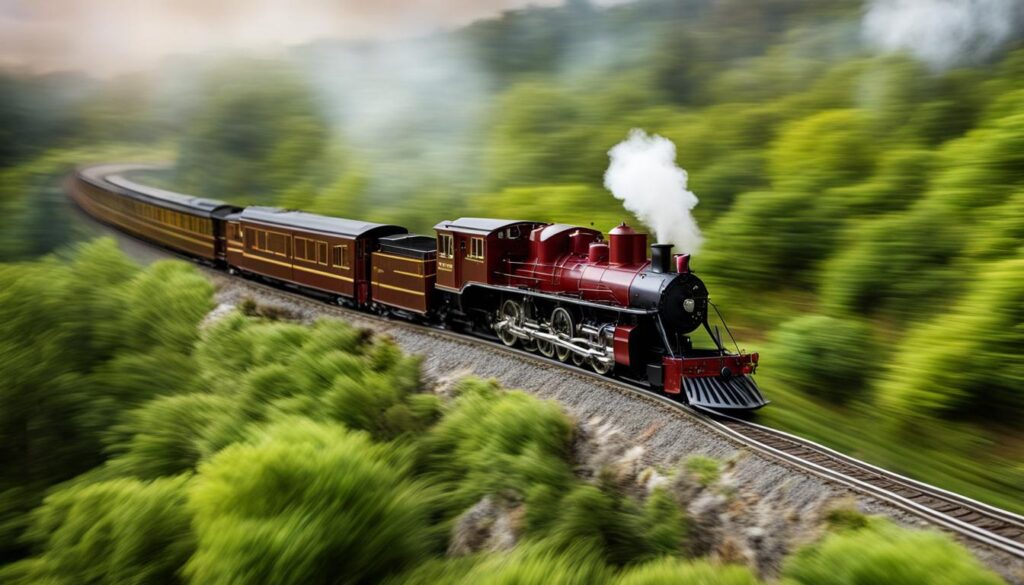

Table: Comparing Uphill Curve Performance
| Model Train Set | Maximum Curvature | Recommended Grade Adjustment |
|---|---|---|
| TrainSetX | 30cm radius | -5% grade reduction |
| TrainSetY | 45cm radius | -3% grade reduction |
| TrainSetZ | 60cm radius | -2% grade reduction |
You can learn more about model train sets by comparing them in the table above. It also shows you how to make the necessary changes for the tricky dance of uphill turns.
But don’t forget to read the manufacturer’s specs and directions, just like you would when you flip through a favorite book. These people will help you figure out how to make each train set work best as it goes around those turns.
Every set has a story that you have to find out. It whispers its own list of changes that should be made to make a simple trip more interesting.
Guidelines for Successful Operation on Grades
There is a tapestry of rules that model train fans can touch to make their trips smooth as they go up and down the hills.
If you follow these rules, running your model trains on rising lines will become more artistic, like listening to a well-planned concert.
Let me break these rules down into their smallest parts. We will find the little things that will make your model train trip even better.
1. Easing Into and Out of the Grade
When your model train starts to go up a hill, move it slowly and steadily, like in a dance. Stay away from quick speed changes and loud notes, as they can send the train off track.
The trick is to slowly change the train’s speed, like adding a soft peak as it gets closer to the hill. This keeps the beat steady and in tune. Also, as the descent goes on, let it be a soft descent, a smooth return to the peace of the level track.
The slow flow and ebb are what make this motion symphony work. The dancing makes sure that the show goes smoothly as it goes over the hills.
2. Reducing the Grade for Model Trains Curved Track Sections
When going uphill, navigating the bumpy scenery of curved track parts makes things more difficult. To breeze through these issues, picture a small change in the grade and a less steep climb on the turns.
When a grade and a curve are used together, they make it harder to follow the steps carefully and make mistakes more likely. In this case, a less steep hill acts as the partner, keeping the two unstable.
Think about the track’s smooth turns and change the grade slowly to make a performance that is both beautiful and reliable.
3. Providing Ample Power to the Train
Model trains that want to easily climb steep hills need to have a lot of power. Choose by hand an engine that can easily go up and down steep hills. Pick a train that has just the right amount of motor power and traction.
A train with a lot of power is like one with just the right amount of torque to keep going fast and get past the speed bumps. To keep your train healthy, clean and fix its motor and wheels on a frequent basis. It will work better with this.
4. Avoiding Switches on Grades
This is crucial for navigating the web-like model train tracks. Known as a switch or turnout.
However, these track-changing tools for grades require careful design. Since the problem is so difficult, avoid putting switches on uphill areas.
Their safety would be best on level routes before or after the slope. This will keep the train on track and reduce its chances of derailing.
5. Supporting the Track Properly
It takes skill to turn your model train base into a stable. The canvas’s robust elements like foam or cork roadbed sustain your uphill track music.
This precise choice absorbs rhythmic vibrations and stops unnecessary moves, stopping derailments. As the train runs along this well designed path, monitoring the track regularly becomes a habit to ensure everything functions properly.
Safety and steadiness are crucial in this creative effort as model trains gracefully ascend. To make the experience exciting and smooth, the choreographer is maintaining the trains and track regularly.
Real-Life Examples – Miniature Railways in Theme Parks
Many people love tiny railways; however, which are often found in theme parks. These railways invite people to go on fun trips on small but strong locomotives.
Each of these whimsical railways shows off its own unique features. In addition, creating an experience that goes beyond simple transportation and turns into an interesting look at numbers and charm.
Let’s find out what these tiny wonders are up to. What’s more, each one is a different part of the magical story of theme park adventures.
Table: Examples of Miniature Railways in Theme Parks
| Park | Maximum Height (feet) | Maximum Angle (degrees) | Track Length (miles) |
|---|---|---|---|
| Wonderland Park | 25 | 10 | 1.5 |
| Fantasy Valley | 30 | 15 | 2 |
| Enchanted Gardens | 20 | 12 | 1 |
In the heart of Wonderland Park, where enchantment meets elevation, the miniature railway unfolds its magic. Additionally, reaching skyward to a maximum height of 25 feet, guests are treated to a spellbinding journey through the park’s captivating landscape.
Moreover, the gentle ascent, with a maximum angle of 10 degrees, adds a touch of whimsy to the experience. Likewise, spanning a charming 1.5 miles, the track weaves through the park’s stunning scenery, inviting guests into a world of wonder.
A New Dimension of Magic
Meanwhile, at Fantasy Valley, the miniature railway elevates the experience to new heights—literally. Additionally, The train ascends to a majestic peak of 30 feet, offering guests breathtaking views that rival the park’s fantastical landscapes.
Moreover, The steeper incline, with a maximum angle of 15 degrees, adds an exhilarating twist to the adventure. What’s more, with a track stretching over 2 miles, guests are immersed in the boundless realms of Fantasy Valley, where every ascent unveils a new dimension of magic.
Not to be outdone, However, Enchanted Gardens’ miniature railway adopts a more modest approach, embracing a maximum height of 20 feet and a gentle angle of 12 degrees.
While not reaching the soaring heights of its counterparts, this railway weaves a captivating journey through the park’s meticulously landscaped gardens.
Covering a serene 1-mile track, guests find solace in the beauty of Enchanted Gardens, where the rhythmic glide along the railway becomes a poetic dance with nature.
In the enchanting realm of theme parks, these tangible tales of miniature railways weave a diverse tapestry of experiences. Moreover, Whether indulging in the gentle cadence of scenic rides or embarking on the thrill of uphill adventures, these miniature railways cast an enchanting spell, adding an extra layer of magic to the overall park experience.
Furthermore, Across these varied landscapes, guests of all ages find themselves immersed in the joyous embrace of miniature train journeys, forging cherished memories that become the heartbeat of their park escapades.
Funicular Railways – An Ingenious Solution for Steep Slopes
When it comes to conquering steep slopes, funicular railways emerge as a brilliant solution. Firstly, weaving together ingenuity and engineering prowess. These exceptional railways rely on a cable system, orchestrating the ascent of trains on inclines without the traditional dependence on wheel traction. Funiculars, timeless marvels, have etched their presence across diverse corners of the globe for decades.
“The magic of funicular railways lies in their mastery of counterbalancing,” shares the insights of railway aficionado John Smith. “As the ascending car gracefully climbs, it’s tethered upward by the weight of its descending counterpart. Therefore, often laden with water or concrete. This harmonious interplay ensures the funicular’s operation with remarkable efficiency and minimal energy consumption.”
Beyond the ballet of counterbalancing, funicular railways often embrace the practical choreography of passing loops. For example, these sections of double track ingeniously facilitate the seamless passage of ascending and descending cars.
Consequently, eliminating the need for halts on the incline. This thoughtful design touch not only elevates the efficiency of the railway but also champions safety. In addition, orchestrating a dance where cars gracefully traverse without a pause.”


Additionally, funicular railways are beloved for their ability to provide a smooth and comfortable ride, making them a popular choice for tourists and locals alike.
Moreover, these railways offer a unique and immersive experience, allowing passengers to connect with the natural beauty of the surrounding landscape.
Furthermore, funicular railways have a rich heritage, adding to their allure and appeal for those seeking a memorable and scenic mode of transportation.
Table: Funicular Railway Examples
| Location | Maximum Incline | Operational Since |
|---|---|---|
| Mount Pilatus, Switzerland | 48% | 1889 |
| Lynton and Lynmouth, England | 52% | 1890 |
| Duisburg, Germany | 35% | 1975 |
As unveiled in the table above, the prowess of funicular railways in conquering substantial inclines is nothing short of extraordinary.
Additionally, these remarkable systems stand as beacons of efficient and dependable transportation, beckoning both daily commuters and curious tourists to effortlessly traverse steep slopes.
Furthermore, be it the ascent of a mountain or the interconnection of diverse urban levels, funiculars persist in unveiling their awe-inspiring engineering prowess.
Conclusion
In summary, the journey of model trains conquering uphill terrain hinges on the delicate interplay of thoughtful design, robust track support, and precise train specifications.
Furthermore, delving into the nuances of factors like track design, train speed, grades, and curves becomes a pivotal undertaking, ushering enthusiasts into the realm of seamless operations.
Likewise, the careful positioning of curves and switchbacks allows for a smooth transition up the slope. Additionally, strategic placement of traction tires and careful monitoring of speed ensure a steady and controlled ascent.
In addition, maintaining a keen eye on the train’s progress and making necessary adjustments along the way is crucial. Lastly, adherence to these principles ultimately leads to the gratifying sight of model trains conquering uphill obstacles with precision and grace.
Firstly, in the language of model railroads, steep grades are described as a dance driven by percentages. Additionally, a good match with the train’s skills is needed. What’s more, there is also an extra level of difficulty added by the uphill curves.
Consequently, a careful method is needed to keep track of design and support. By taking these things into account and following the rules given, you can make the experience of driving model trains uphill more enjoyable. Ultimately, the way to a successful operation turns into a blank canvas where the beauty of model railroading can shine through.
FAQ
Can model trains go uphill?
Yes, model trains can go uphill. However, their ability to navigate inclines depends on various factors such as the track design, track gradient, train speed, and train specifications.
What factors affect a model train’s ability to climb uphill?
The factors that affect a model train’s ability to climb uphill include the design of the track, the grade or slope of the track, the train’s weight, the power of the locomotive, and the train’s overall design.
How should the track be designed for uphill climbing?
The track should be built with a suitable incline or gradient that matches the train’s capabilities. It should have proper support to prevent derailments and ensure stability.
What influences a model train’s uphill speed?
A model train’s uphill speed is influenced by factors such as the weight of the train, the power of the locomotive, and the overall design of the train. A heavier train may struggle to maintain speed, while a powerful locomotive can provide the necessary propulsion.
How are uphill grades expressed in model railways?
Uphill grades in model railways are expressed as a percentage, indicating the rise in height per unit of distance. Different models of trains have different capabilities when it comes to handling various grades.
What challenges do uphill curves pose for model trains?
Uphill curves can affect a model train’s ability to maintain speed and prevent derailments. The sharper the curve, the more significant the reduction in grade might be necessary. Proper track design and support are essential for navigating uphill curves effectively.
What guidelines should be followed for successful operation on grades?
To ensure reliable operation on grades, model train enthusiasts should follow guidelines such as easing into and out of the grade, reducing the grade for curved track sections, providing ample power to the train, avoiding switches on grades, and supporting the track properly.
Are there real-life examples of trains navigating inclines successfully?
Yes, miniature railways in theme parks provide real-life examples of trains successfully navigating inclines. These railways vary in their maximum heights and angles, offering guests a pleasant ride on powered locomotives.
How do funicular railways solve the challenge of steep slopes?
Funicular railways use a cable system to pull trains up inclines, mitigating the need for traction on the wheels. The use of counterbalancing and passing loops adds to the efficiency of these railways, making them a remarkable feat of engineering.

